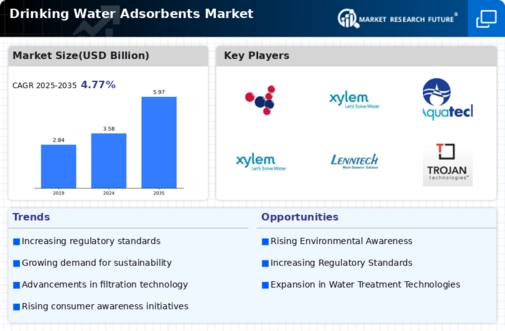Market Growth Projections
The Global Drinking Water Adsorbents Market Industry is projected to experience substantial growth in the coming years. With an estimated market value of 3.58 USD Billion in 2024, it is anticipated to reach 5.97 USD Billion by 2035. This growth trajectory indicates a compound annual growth rate of 4.76% from 2025 to 2035. The increasing demand for effective water treatment solutions, driven by factors such as contamination, regulatory pressures, and technological advancements, underscores the market's potential. These projections highlight the importance of adsorbents in ensuring safe drinking water for a growing global population.
Growing Awareness of Water Quality
Public awareness regarding the importance of water quality is a key driver for the Global Drinking Water Adsorbents Market Industry. As consumers become more informed about the health risks associated with contaminated water, they are increasingly seeking products that ensure safe drinking water. This trend is reflected in the rising sales of water purification systems that utilize adsorbents for contaminant removal. Educational campaigns and advocacy for clean water initiatives further amplify this awareness, leading to a heightened demand for effective adsorbent solutions. Consequently, the market is poised for growth as consumers prioritize water safety in their purchasing decisions.
Rising Population and Urbanization
The Global Drinking Water Adsorbents Market Industry is also propelled by the rising global population and rapid urbanization. As more individuals migrate to urban areas, the demand for clean drinking water intensifies. Urban centers often face challenges related to water supply and quality, necessitating the implementation of effective treatment solutions. Adsorbents play a crucial role in addressing these challenges by providing efficient methods for removing contaminants from water sources. This trend is expected to contribute to the market's expansion, as urban populations continue to grow and the need for reliable water treatment solutions becomes increasingly critical.
Regulatory Frameworks and Standards
The Global Drinking Water Adsorbents Market Industry is significantly influenced by stringent regulatory frameworks aimed at ensuring safe drinking water. Governments worldwide are implementing regulations that mandate the reduction of specific contaminants in drinking water. For example, the U.S. Environmental Protection Agency has established guidelines for maximum contaminant levels, driving the need for effective adsorbents. Compliance with these regulations often requires the use of advanced treatment technologies, including adsorbents, to meet safety standards. This regulatory pressure is likely to propel the market towards an estimated value of 5.97 USD Billion by 2035, reflecting a compound annual growth rate of 4.76% from 2025 to 2035.
Increasing Water Contamination Levels
The Global Drinking Water Adsorbents Market Industry is experiencing growth due to rising levels of water contamination. Industrial activities, agricultural runoff, and urbanization contribute to the presence of harmful pollutants in drinking water sources. For instance, heavy metals and organic compounds are increasingly detected in water supplies, necessitating effective treatment solutions. Adsorbents such as activated carbon and zeolites are employed to mitigate these contaminants, enhancing water quality. As public awareness of water safety grows, the demand for adsorbents is expected to rise, contributing to the market's projected value of 3.58 USD Billion in 2024.
Technological Advancements in Adsorbent Materials
Innovations in adsorbent materials are shaping the Global Drinking Water Adsorbents Market Industry. The development of advanced materials, such as nanomaterials and bio-based adsorbents, enhances the efficiency of contaminant removal from water. These innovations not only improve adsorption capacity but also reduce the environmental impact of adsorbent production. For instance, researchers are exploring the use of agricultural waste as a sustainable source for adsorbents. As these technologies become more commercially viable, they are expected to attract investment and drive market growth, aligning with the increasing demand for effective water treatment solutions.



















Leave a Comment